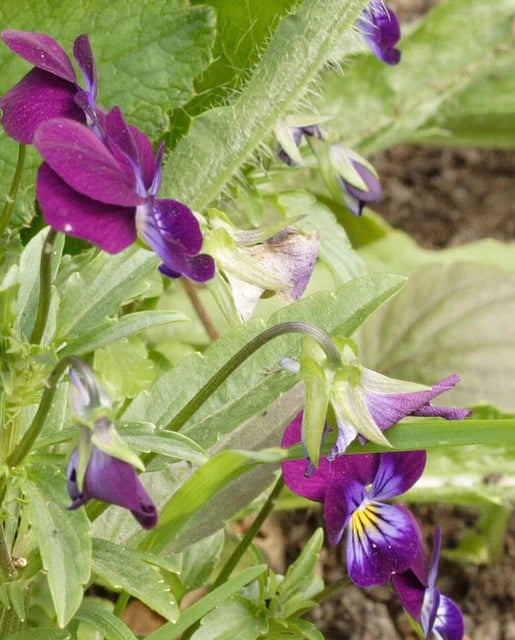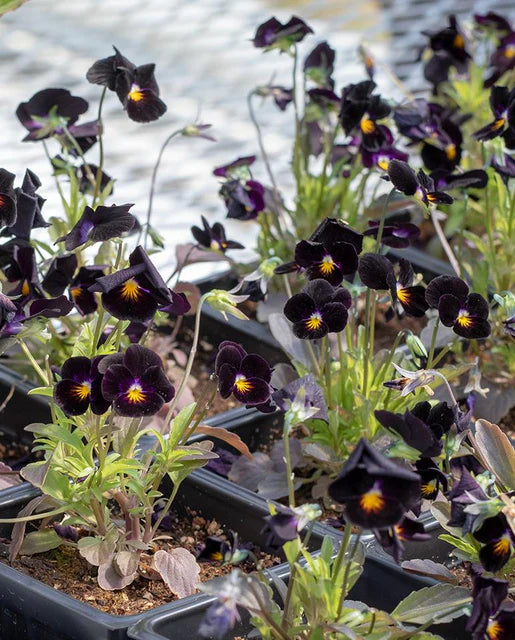77 products
77 products
Sort by:
Flower Seeds
Viola cornuta. These perky little flowers are old-fashioned heirloom favourites and look like miniature pansies with lavender, yellow, and white faces. Direct seed Johnny Jump Up viola seeds from April to July. Sow seeds 0.6cm (0.25") deep, and they should germinate in 12-14 days. Johnny Jump Up viola seeds self sow fairly readily, but they do not take over, and can be easily raked under if unwanted. These look rather good in containers, and their flowers are edible. If you want to try your hand at making candied violets, Johnny Jump Ups are the place to start. Or simply pick some of the fresh flowers and scatter them over salads and summer meals.
Hardy Annual
Viola cornuta. We loved this petite pansy as soon as it bloomed, and it bloomed in the first year, over a long period. Just 14 to 16 weeks after seeding, its small, very dark, and flat-faced flowers began to appear. With regular deadheading Back to Black just blooms and blooms. The foliar growth is vigorous, but the stature of the plants remains compact at about 15cm (6") tall. It would look great in containers or window boxes, but it takes on a wonderful appearance in mass plantings. The flowers are actually very deep purple, but so deep that they appear black from a few feet away. Each delicate flower is streaked in the centre by a brush of golden yellow. The edible flower petals look amazing scattered on ice cream. Sow in early spring for summer flowers, or as late as July for winter blooms. It's hardy in Zones 5 to 9.
Perennial
Cortaderia selloana. This familiar ornamental grass takes three years to reach maturity from seed, but the end result is magnificent. A fountain of soft blue-grey foliage erupts from the centre of a massive clump. Above this, from late summer right into winter stand the distinctive, feathery panicles up to 3m (10') high. White Pampas Grass makes a bold statement wherever it is planted, and can be used as an architectural feature in garden design, anchoring or framing garden spaces. The inflorescences are fantastic as dry or fresh cut flowers.
Use 50 seeds per two foot diameter planting to create the dense clump look. Simply press the seeds lightly into moist soil indoors or direct sown. The seeds need light to germinate, so avoid covering them. The leaves of this fast-growing grass have sharp edges. White Pampas Grass is hardy to Zone 7, but can be overwintered in cooler zones by mulching over the roots in winter.
A High yielding mix that produces large, densely petaled flowers for multiple cuts over the season. Benary’s Giant is the standard zinnia for cut flower growers for its vigorous growth and long-lasting blooms in multiple colours including red, coral, lime, wine, pink, white, purple, and yellow. Widely adapted. Grows to 100-125cm (40-50”)
A special blend for the cut flower grower and owners of big vases! Giant Blue Point Zinnias produce dahlia-flowered zinnias with tall stems in large double blooms. Crimson red, lilac, rose, canary yellow, deep red, white and orange. This is the earliest flowering variety. Giant Blue Point Formula zinnia seeds zinnias are long blooming with excellent disease resistance. Picking off the dead flowers (deadheading) will prolong the bloom time, but so will cutting them for bouquets. The colours are brilliant and the stems are strong and upright, perfect for cutting.
Annual.
The Queeny Series offers a step above the standards with their elegant colour combinations. Queeny Lime Red is a stunner with dark pink outer petals that become paler, transforming into a lime green ring around the pink center. Mostly double and semi-double blooms with a small percentage of singles, yielding multiple cuts throughout the season. Plants are 75-100cm (30-40”) tall.
The Queeny Series offers a step above the standards with their elegant colour combinations. Queeny Lime with Blotch has pale yellow to chartreuse petals with a pop of pink in the center. Mostly double and semi-double blooms with a small percentage of singles, yielding multiple cuts throughout the season. Plants are 75-100cm (30-40”) tall.
Zinnia elegans. We grew a wide range of Zinnias in the summer field trials, but this one really stood out. Queeny Lime Orange Zinnias have branching stems that grow to about 90cm (36") tall. Atop each stem is a flower of immense beauty that starts out lime green, but as its petals unfold they turn to deep peach and then orange. This colour range looks wonderful in bouquets. As cut flowers they are long lasting and luxuriant, and in the garden they are abuzz with bumble bees. The plants respond well to cutting, with more flowers forming all the time. The bloom period is from mid-summer right into September.
Annual.
A blend of wildflowers that are not preferred food sources for deer or are resilient to being foraged. In times of weak grazing, deer may still nibble on these plants, but the contents of Deer Resistant wildflower seeds were chosen for their resilience to deer. Great for planting on the Gulf Islands and BC Interior, where deer can be a real nuisance. The mix will also work in any other North American setting, attracting pollinators like bees and butterflies, but foiling marauding deer. Recommended rate of application: 115g per 1,000 square feet.
Viola cornuta. This spreading hybrid pansy has exceptional overwintering ability. Ruffled petals in a wide range of colours bring a dramatic splash of vibrancy to the winter garden. Sow Fizzy Fruit Salad Mix Viola seeds in July and August for blooms from October right through to the following May. They look incredible in containers and hanging baskets, and particularly spectacular in mass bedding plantings. The wide pansy faces, fancy frilled petals, and dazzling colours bring a really special look to any garden. Much needed colour for an otherwise subdued winter palette. Be sure to plant your winter flowering pansies the previous summer.
Perennial (Grow as a hardy annual)
Lathyrus odoratus. Unlike Mammoth, Supersnoop Mix sweet pea seeds produce a compact dwarf variety that is well suited to tubs, containers, and the front of the flower bed. It is an improved Snoopea type that blooms early in a wide range of colours. The plants have no tendrils, so they stay low and compact at 45-60cm (18-24") tall. Supersnoop produces flowers that are showy and mildly fragrant and well suited for cut flowers. Supersnoop are great for market growers for bundles of cut flowers. Direct sow sweet pea seeds between March and May at regular intervals to prolong the bloom period. Be sure to pick any seed pods that appear so the flowers keep coming.
Annual
Lathyrus odoratus. Striking shades of crimson, lavender, deep rose, navy blue, rose pink, and salmon, these climbers are 1.6m (6ft) and perfect for cut flowers. Sow Mammoth Blend sweet pea seeds for the earliest sweet peas to bloom from late spring to early summer. Direct sow sweet pea seeds at three week intervals for an extended bloom period. This variety has particularly large flowers on particularly long stems, so they're a great cut flower for the farm table or the home garden. While they have a distinct fragrance, they are not like the intense Spencers or High Scent, so they will appeal to growers who prefer subdued scents.
Annual
Dwarf sunflower for containers and small garden beds, perfect for children to plant! Big Smile has the classic bright sunny-yellow petals with a dark center. Compact, branching plants are 25-38cm (10-15”) when grown in pots and slightly taller at 30-60cm (12-24”) when grown in the garden. Bears Pollen.
With so many to choose from and only so much space in the garden, Tall Blend sunflower seeds will allow you to enjoy a mixed planting. This package combines varieties of tall sunflowers to brighten up the back of the garden. Grow a forest of giants that attract pollinators to your garden and also feed the birds once the flowering show is over. All plants in this collection will grow to 2-4m (6-12').















